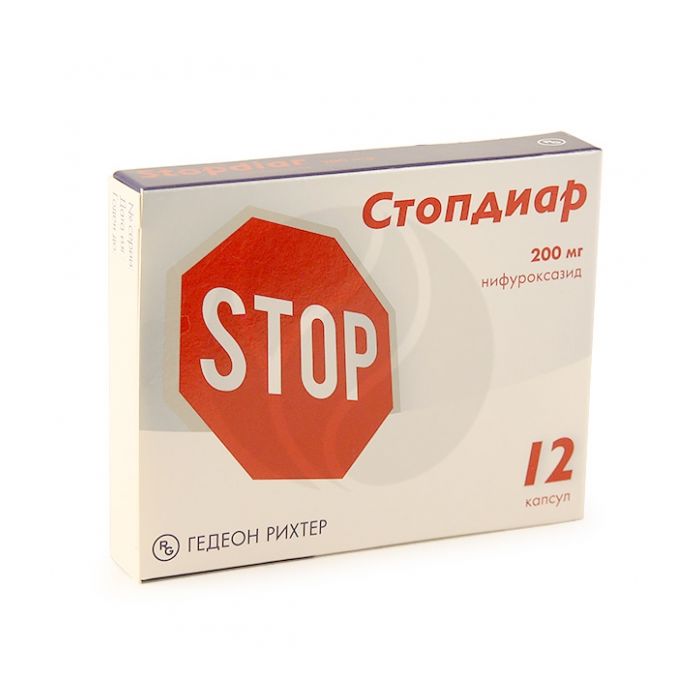Stopdiar capsules 200mg, No. 12
Expiration Date: 11/2025
Russian Pharmacy name:
Стопдиар капсулы 200мг, №12
Acute bacterial diarrhea, proceeding without deterioration of the general condition, fever, intoxication.
Inside. Adults and children over 6 years old: 1 capsule (200 mg) 4 times a day; daily dose 800 mg.
Children 3-6 years old: 1 capsule (200 mg) 3 times a day; daily dose 600 mg.
If during the first three days there is no improvement, then you should consult a doctor.
Active substance:
Nifuroxazide - 200 mg
Excipients:
corn starch, sucrose, pregelatinized corn starch, magnesium stearate.
The composition of the capsule cap : gelatin, titanium dioxide, iron oxide yellow dye.
The composition of the capsule body: gelatin, titanium dioxide, iron oxide yellow dye.
Hypersensitivity to nifuroxazide, nitrofuran derivatives or any excipients of the drug; children under 3 years old; pregnancy; fructose intolerance, glucose-galactose malabsorption syndrome or sucrase and isomaltase deficiency (due to the presence of sucrose in the preparation).
International non-proprietary name
Nifuroxazide.
Tradename:
STOPDIAR.
Description of the dosage form
Hard gelatin capsules, size 1. The cap and body of the capsule are yellow. The contents of the capsules are yellow powder.
Ingredients: 1 drop.
Active substance:
Nifuroxazide - 200 mg
Excipients:
corn starch, sucrose, pregelatinized corn starch, magnesium stearate.
The composition of the capsule cap : gelatin, titanium dioxide, iron oxide yellow dye.
The composition of the capsule body: gelatin, titanium dioxide, iron oxide yellow dye.
pharmachologic effect
Antimicrobial.
Pharmacodynamics
Nifuroxazide is highly active against Campylobacter jejuni, Escherichia coli, Salmonella spp., Shigella spp .; Clostrifium perfringens, Vibrio cholerae, pathogenic Vibrions and Vibrio parahemolytique, Staphylococcus spp. Weakly sensitive to nifuroxazide: Citrobacter spp., Entegobacter cloacae and Proteus indologenes. Resistant to nifuroxazide: Klebsiella spp., Proteus mirabilis, Providencia spp., Pseudomonas spp.
Nifuroxazide does not affect the composition of the normal bacterial flora of the digestive tract.
Nifuroxazide presumably inhibits the activity of dehydrogenases and protein synthesis in bacterial cells.
It does not cause the emergence of drug-resistant strains, and cross-resistance with other antibacterial drugs was not observed, which makes it possible, if necessary, for generalized infections to use it in complex therapy with systemic drugs.
In case of intestinal infections of viral genesis, it prevents the development of bacterial superinfection. The effectiveness of nifuroxazide does not depend on the pH in the intestinal lumen or on the sensitivity of microorganisms to antibacterial drugs. The drug is practically not absorbed from the digestive tract, it acts exclusively in the intestinal lumen. The effect appears from the first hours of treatment.
Pharmacokinetics
Nifuroxazide is excreted by the intestines: 20% is unchanged, and the rest of nifuroxazide is chemically altered.
Indications
Acute bacterial diarrhea, proceeding without deterioration of the general condition, fever, intoxication.
Contraindications
Hypersensitivity to nifuroxazide, nitrofuran derivatives or any excipients of the drug; children under 3 years old; pregnancy; fructose intolerance, glucose-galactose malabsorption syndrome or sucrase and isomaltase deficiency (due to the presence of sucrose in the preparation).
Application during pregnancy and lactation
Use during pregnancy is contraindicated. Breastfeeding is permissible only in the case of a short course of drug treatment.
Side effects
Allergic reactions such as skin rashes, urticaria, Quincke's edema, anaphylactic shock. If any of the side effects indicated in the description are aggravated, or the patient has noticed any other side effects, the doctor should be informed about it.
Interaction
With simultaneous use with ethanol, a disulfiram-like reaction may develop (abdominal pain, nausea, vomiting, headache, tachycardia, blurred vision, weakness, convulsions). Simultaneous use with drugs that inhibit the function of the central nervous system is not recommended.
Method of administration and dosage
Inside. Adults and children over 6 years old: 1 capsule (200 mg) 4 times a day; daily dose 800 mg.
Children 3-6 years old: 1 capsule (200 mg) 3 times a day; daily dose 600 mg.
If during the first three days there is no improvement, then you should consult a doctor.
Overdose
There is no data.
special instructions
In the case of bacterial diarrhea with signs of systemic damage (deterioration of the general condition, fever, symptoms of intoxication or infection), you should consult a doctor to decide on the use of antibacterial drugs of systemic action.
Stopdiar should be used for no more than 7 days. There are no indications for long-term therapy. If persistent diarrhea persists for more than 3 days, consult a doctor.
In the case of severe invasive diarrhea, it is recommended to use systemic antibiotics, since nifuroxazide is not absorbed in the gastrointestinal tract.
With the development of hypersensitivity reactions (shortness of breath, swelling of the face, lips, tongue, skin rash, itching), stop taking the drug Stopdiar immediately.
While taking the drug Stopdiar, it is necessary to follow a diet, including the exclusion of juices, raw vegetables and fruits, spices and heavy foods.
While taking the drug Stopdiar in the treatment of acute diarrhea, continuous rehydration therapy (oral or intravenous) should be carried out, depending on the general condition of the patient.
During treatment with nifuroxazide, alcohol is prohibited.
Influence on the ability to drive vehicles and work with mechanisms
The drug does not affect the ability to drive vehicles and mechanisms.
Release form
Capsules, 200 mg. In a blister made of aluminum / PVC, 12 pcs. 1 blister in a cardboard box.
Conditions of dispensing from pharmacies
Without recipe.
Storage conditions
At a temperature not exceeding 25 ? C.
Keep out of the reach of children.
Shelf life
2 years.
Do not use after the expiration date printed on the package.

